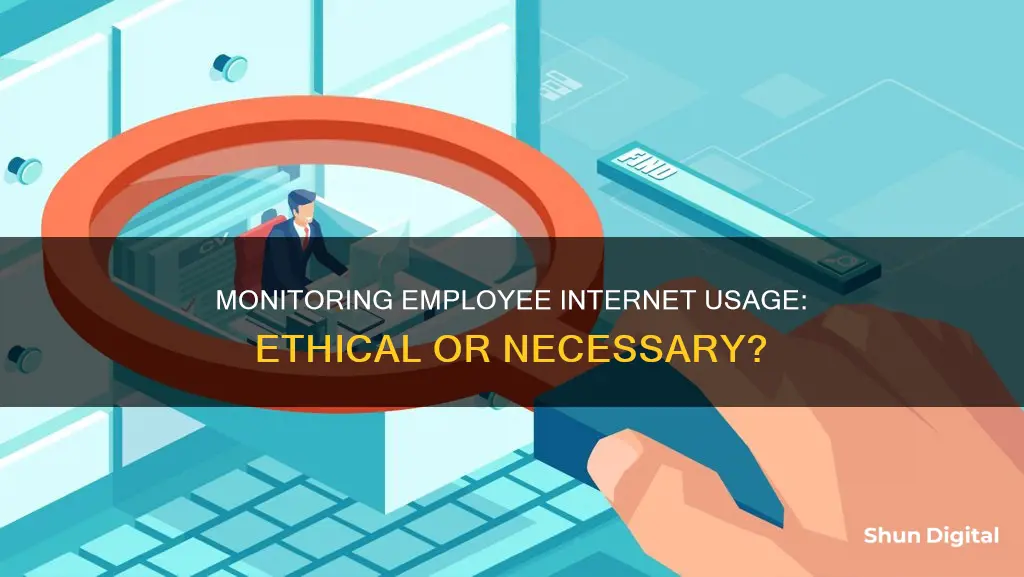
Should managers monitor employee internet usage? This is a question many organizations are asking as the modern workplace continues to evolve, with remote work and digital tools becoming the norm. While monitoring employee internet activity can help improve productivity, security, and compliance, it also raises ethical and legal considerations.
On the one hand, employers have a responsibility to protect their business interests, ensure smooth operations, and maintain a productive workforce. Unchecked internet use can lead to security risks, decreased productivity, and compromised company resources. By monitoring employee internet usage, employers can gain insights into potential distractions, identify training needs, and enforce company policies.
However, monitoring employee internet activity can also invade privacy, decrease morale, and lead to complex technical and legal challenges. Employers must navigate various laws and regulations, such as data protection and privacy laws, to ensure ethical and compliant monitoring practices.
So, what is the best approach for organizations? It lies in finding a balance between monitoring for legitimate business purposes and respecting employee privacy. This involves establishing clear and transparent policies, obtaining consent, and using appropriate software and technologies to track and manage employee internet usage.
As the digital landscape continues to shape the way we work, organizations must adapt and find effective solutions to enhance productivity and security while maintaining a culture of trust and accountability.
| Characteristics | Values |
|---|---|
| Purpose | Protect company assets and ensure smooth functioning of daily operations |
| Reason | Unchecked internet use increases security risks, impacts productivity, and compromises company resources |
| Benefits | Enhance productivity, protect company information, identify training needs |
| Challenges | Privacy concerns, potential for misuse, technical difficulties and costs |
| Types of Monitoring | Restrict internet usage, implement a BYOD policy, ban specific websites, use an employee monitoring tool |
| Methods | Configure router, use proxy servers and firewalls, use computer monitoring software |
| Data Collection | Websites visited, URLs accessed, time spent on each site, file downloads and uploads, emails, chat messages |
| Data Storage | Stored securely on the employee's computer or a centralized server |
| Reporting and Analysis | Reports and analytics based on captured data, including websites visited, time spent on activities, productivity levels |
| Alerts and Notifications | Set up for specific activities or events, e.g. visiting prohibited websites |
| Legal Status | Legal in the US, but with some state-specific requirements; varies in other countries |
What You'll Learn

Privacy concerns and ethical considerations
Transparency and Consent:
Employers should be transparent about their monitoring practices and obtain employees' consent. This includes informing employees of the purpose, scope, and methods of monitoring. Creating a clear monitoring policy that employees sign, granting consent, is advisable. Transparency builds trust and ensures employees don't feel spied on.
Data Security and Privacy:
Collected data must be securely stored and accessed only by authorized personnel. Encryption, complex passwords, and multi-factor authentication protect data from unauthorized access. Regular updates and security patches address vulnerabilities. Anonymization techniques, such as scrambling user identities, further protect employee privacy.
Legal Compliance:
Employers must comply with relevant laws and regulations, such as the General Data Protection Regulation (GDPR) in the EU or state-specific privacy laws in the US. Monitoring laws vary by jurisdiction, so understanding and adhering to local regulations is crucial. Seeking legal counsel when developing policies is recommended.
Balancing Productivity and Privacy:
Employers should aim for a balanced approach, monitoring only what is necessary for legitimate business purposes while respecting employee privacy. This includes restricting monitoring to specific devices, times, and activities, such as tracking company-owned devices during working hours. Employers should also provide clear guidelines on acceptable and prohibited internet use, blocking or restricting access to certain sites rather than banning them outright.
Employee Input and Trust:
Involving employees in the policy-making process through anonymous surveys helps address their concerns proactively. Employers should use monitoring data primarily for constructive feedback and counselling rather than punitive action. Discipline should be a last resort for repeated or egregious violations.
Technical Challenges:
Monitoring across various devices and networks, especially with remote work and personal devices, presents technical complexities. Employers must ensure the accuracy and reliability of monitoring systems while respecting privacy. This includes managing complex setup and management processes for monitoring software and hardware.
In summary, while monitoring employee internet usage has benefits, employers must navigate a fine line to respect employees' privacy rights and ethical boundaries. A measured approach, with transparency, consent, and clear policies, is essential to maintaining trust and compliance while improving productivity and security.
Monitor Usage: Afterburner's Impact and Performance Revealed
You may want to see also

Security risks and data breaches
Firstly, it is important to understand the types of online activity that can be monitored. This includes tracking browser history, file transfers, messages, or keyboard and mouse activity. Monitoring these activities can help identify potential security threats and protect sensitive company data. For example, monitoring file transfers can prevent malware attacks, as even seemingly harmless transfers are vulnerable to such attacks. Similarly, monitoring messages can help detect the sharing of secure information, such as credit card details, via unprotected email.
In addition, monitoring employee internet usage can help identify insider cybersecurity threats. Unchecked internet use increases security risks and makes organizations vulnerable to data breaches. For instance, employees may unintentionally install spyware by downloading unauthorized software or fall victim to email phishing scams that compromise workplace systems. Monitoring can also help enforce security policies and ensure that company resources are used appropriately. By tracking the websites visited and applications used, employers can identify when employees are accessing unsafe or inappropriate sites that could compromise security.
Furthermore, monitoring can help protect against viruses and hackers. Network monitoring can deter hackers and help identify potential breaches. If an IT team is consistently troubleshooting issues, monitoring tools can help retrace steps and locate the source of the breach. Monitoring can also help identify productivity issues and ensure employees are not wasting time on non-work-related activities. This, in turn, can reduce the risk of data breaches by limiting the exposure of sensitive information.
While monitoring employee internet usage is essential, it must be done ethically and with transparency. Employers must balance protecting their interests with respecting employees' privacy rights. Informing employees of monitoring practices and obtaining their consent is crucial to maintaining trust and avoiding legal issues.
University WiFi: Staff Privacy and Monitoring Concerns
You may want to see also

Productivity and performance tracking
Monitoring employee internet usage can be a powerful tool for managers to track productivity and performance. This can be especially important for remote teams, where distractions are more prevalent and it is easier for employees to become unfocused.
Benefits
By tracking internet usage, managers can gain data on how and when employees are most productive. This can help identify potential blockers to productivity, such as excessive time spent on non-work-related websites or social media during work hours. With this information, managers can implement targeted training programs or policies to address these concerns and improve overall efficiency.
For example, if an employee is constantly checking social media during work hours, their focus is interrupted and tasks take much longer than necessary, wasting company time. Monitoring can help managers identify this and take steps to correct it.
Additionally, tracking internet usage can help enforce company policies on internet usage. For instance, if a company has a policy of only allowing social media use during break times, monitoring can ensure this policy is adhered to.
Methods
There are several methods for tracking employee internet usage:
- Time-tracking software: This allows employees to log their work hours and the time spent on specific tasks or projects. It may also include features like screenshots, activity levels, and idle time monitoring.
- Project management software: These platforms help track the progress and status of tasks and projects and often include features that allow managers to monitor employee workloads and task completion rates.
- Communication and collaboration tools: Instant messaging platforms, video conferencing software, and project collaboration tools can be used to track employee communication, collaboration, and responsiveness.
- Web and application monitoring: Software can be used to monitor the websites and applications accessed during work hours, ensuring compliance with company policies and preventing unauthorized activities.
- Performance analytics: These tools analyze employee productivity, efficiency, and output based on data collected from various tracking sources, generating reports and insights to evaluate individual and team performance.
Considerations
While tracking employee internet usage can provide benefits, there are several considerations:
- Privacy concerns: This is a significant obstacle, and it is important to establish clear policies about how and why employee internet usage will be tracked. Employees should be made aware of the purpose of monitoring software and understand that it is not intended to invade their privacy.
- Potential for misuse: Employers must strictly adhere to policies and guidelines to prevent any unwarranted use of the collected data. Transparency is key, and the gathered information should be used solely for its intended purpose of improving productivity and safeguarding company assets.
- Technical difficulties and costs: Implementing employee internet monitoring solutions can be technically challenging and incur costs. Employers need to invest in appropriate monitoring tools and ensure they have the resources to address any technical issues promptly.
- Legal regulations: Depending on the jurisdiction, there may be legal regulations and requirements regarding an employer's ability to monitor employee internet usage. For example, in the US, while it is legal, employees must be made aware of the monitoring practices. In the EU, monitoring policies must be limited to legitimate business needs.
Monitor Smart TV Data Usage: Tips for Parents
You may want to see also

Compliance with legal and regulatory requirements
- Data Security and Privacy: Employers have a responsibility to protect sensitive employee information and privacy. Monitoring employee internet activity helps ensure that private data is not disclosed or misused. This includes compliance with privacy laws such as HIPAA in the United States.
- Legal Repercussions: Failure to comply with privacy laws and regulations can result in legal repercussions for organisations. Monitoring employee internet usage helps organisations avoid legal liabilities and penalties by ensuring they collect, store and manage employee data securely.
- Ethical Behaviour: Monitoring employee internet usage can foster a culture of ethical behaviour within the organisation. By being transparent about monitoring practices and obtaining employee consent, employers can build trust and ensure that employees are aware of the boundaries of acceptable internet usage.
- Accountability and Integrity: Employee internet monitoring can promote a culture of accountability and integrity. When employees are aware that their internet usage is being monitored, they are more likely to adhere to company guidelines and less likely to engage in unethical behaviour or misconduct.
- Training and Policy Improvements: Monitoring employee internet usage provides valuable data on employee productivity and potential blockers to efficiency. This data can be used to identify training needs and implement targeted programs to address compliance gaps. Additionally, monitoring can help identify employees who require additional guidance or policy clarification to ensure they understand and adhere to regulatory requirements.
- Risk Mitigation: Monitoring employee internet activity is crucial for risk mitigation, especially regarding cyber threats and data breaches. By tracking employee internet usage, organisations can identify potential security risks, such as unauthorised data sharing or visits to unsafe websites, and take proactive measures to protect sensitive information.
- Litigation and Evidence: Employee monitoring can provide evidence for potential litigation or disputes. Archived data, including employee emails, browser history and keystrokes, may be necessary to retain for legal purposes.
Monitoring Power Usage: Track Your Appliance Energy Consumption
You may want to see also

Employee training and awareness
- Data Security Best Practices: Educate your employees about data security and the potential risks associated with internet usage. Teach them how to create and manage strong passwords, identify phishing attempts, and avoid suspicious websites or downloads that may compromise sensitive information.
- Time Management and Time Theft: Raise awareness about the importance of effective time management. Discourage time theft practices, such as excessive personal browsing during work hours, to improve employee performance and productivity.
- Clear Guidelines: Set and communicate clear guidelines on acceptable computer and internet usage. Ensure employees understand what is expected of them and the boundaries they should respect. This includes guidelines for using company devices, accessing personal emails or social media, and browsing non-work-related websites.
- Security Measures: Implement strong data security measures to protect company information. This includes regular password changes, complex passwords, and multi-factor authentication to protect critical systems and data.
- Phishing Awareness: Train employees to identify phishing emails and other forms of social engineering attacks. Phishing is one of the most common methods used by attackers to gain access to sensitive information. Employees should be able to recognize and report suspicious emails or links.
- Regular Updates: Keep your employees informed about the latest security threats and best practices. Schedule regular training sessions or workshops to ensure they stay vigilant and aware of evolving risks.
- Ethical Considerations: Emphasize the ethical implications of internet usage monitoring. Explain that monitoring is not intended to invade their privacy but to protect the company's assets and ensure a productive work environment. Transparency and trust are essential in this process.
- Productivity Tools: Provide employees with productivity tools and resources to help them manage their time effectively. This can include time-tracking software, project management platforms, or communication tools that facilitate collaboration and improve efficiency.
- Consequences of Misuse: Clearly outline the consequences of inappropriate internet usage or violations of company policy. Explain how misuse can lead to disciplinary action, including the specific steps that will be taken in response to policy breaches.
- Continuous Learning: Encourage a culture of continuous learning and improvement. Provide resources and support for employees to enhance their digital skills and security awareness. This can include online courses, workshops, or internal training programs tailored to their roles and responsibilities.
By investing in employee training and awareness, organizations can empower their employees to make informed decisions about internet usage, protect sensitive information, and maintain a productive and secure work environment.
Additionally, it's important to remember that monitoring practices should always be accompanied by clear communication and respect for employee privacy rights. Transparency and ethical considerations are vital to maintaining a positive and trusting relationship between employers and employees.
Monitoring Electricity Usage: A Guide to Tracking Your Power Consumption
You may want to see also
Frequently asked questions
Monitoring employee internet usage can help to enhance productivity, protect company information, and identify training needs. It also helps to ensure compliance with legal and regulatory requirements, especially in highly regulated industries.
Privacy concerns are a significant obstacle, and there is a potential for misuse of the collected data. Implementing employee internet monitoring solutions can also be technically challenging and costly.
In the United States, monitoring employee internet activity on company-owned computers is legal. However, employers must be mindful of privacy laws and employee consent, which may vary by state. Similar considerations apply in other jurisdictions, such as the EU, Canada, and Australia.







